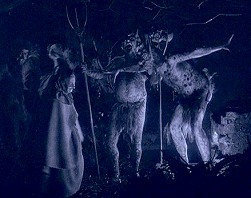![[Deep Focus]](../../flicker/longo.gif)

She's a witch!
![[Deep Focus]](../../flicker/longo.gif)
|
|
| Häxan
|
|

|
|
She's a witch! |
|
|
Movie Credits: Written and directed by Benjamin Christensen Cinematography by Johan Ankerstjerne Edited by Edla Hansen Starring Astrid Holm, Karen Winther, Maren Pedersen, Wilhelmine Henriksen, Kate Fabian and Oscar Stribolt Sweden, 1922 Aspect ratio: 1.33:1 Screened on DVD (Criterion Collection) |
A silent fim dealing with the historical facts of witch-hunting in whimsical yet tragic terms, Benjamin Christensen's Häxan predates The Passion of Joan of Arc by several years but shares striking similarities to that film in both themes and aesthetics. If it isn't nearly as great as Dreyer's film, it's quite a bit more fun, and Criterion's DVD highlights Christensen's spectacular showmanship while simultaneously paying careful attention to his conscience. Christensen was an otherwise-obscure Danish director (his English-language film Seven Footprints to Satan is often sought after by buffs) with obvious theatrical flair. His flamboyance is most evident in the scenes here where he plays Satan. But there are other touches that will stop film buffs short, like the wicked little stop-motion demon who clambers through a doorway, or the glimpses of nudity that bring a classical eroticism to witch lore. In substance, Häxan is a serious consideration of the historical witch hunts. As such, it is one of the earliest films that takes misogyny and sexual repression as its subject, boldly condemning the resort to religious piety as an excuse for the sadistic torture and ritualistic slaughter of innocent women. Christensen's source for much of this material is a 1487 tract known as Malleus Malificarum, or The Hammer of Witches, which was, according to Swedish film scholar Casper Syberg's DVD commentary, an influential work on the subject of identifying and trying "witches." Syberg says Christensen himself described the book as "the most scurrilous document in the history of the world." Christensen's screed against witch-hunters - and the church in general - is balanced by the winking humor of the scenes that portray the underworld as one long, nonstop par-tay, with the devil himself presiding over the festivities. What makes Häxan memorable is Christensen's remarkable quasi-documentary approach, which must have been awfully sophisticated stuff in 1922. The first section of the film is presented in the dry, educational style familiar to anyone who attended public shools. Silent intertitles introduce and explain illustrations taken from period sources - Christensen himself compiled a bibliography to acompany the film - that depict a fantastic underworld where witches and demons routinely cavort. Before long, Christensen shifts into docudrama mode, with a sketch-like dramatization of witchery in which a woman solicits a magic potion so that a friar might fall in love with her. The tone of these episodes, which later depict torture devices and illustrate tactics for eliciting confessions from accused witches, is an odd mix of tragedy and whimsy. Indeed, despite the obvious relish Christensen takes in portraying the devil's own bad self, an embodiment of the fears and hypocrisies of the ostensibly faithful, he displays an empathy for the women accused that's akin to that which Dreyer would subsequently afford his Joan. On first viewing, I wasn't at all sure what to make of all this. On a second viewing, Christensen's angle on the witch hunts and the church's role in them gains coherence - even if the final section, which dwells clinically on female "hysteria" as a latter-day explanation of witchy behavior, seems too quaint by far. Notably, Christensen spends as much time scrutinizing the motives and behavior of the holy men who claim that they can see witches among women as he does immersing himself in the more easily scandalous lore of witchery itself. Like Dreyer's Passion, Häxan remains surprisingly fresh - simultaneously a rollicking supernatural historical docudrama without peer, and an indictment of those who would pursue witchhunts in any era. In typical Criterion style, DVD producer Issa Clubb has adroitly assembled materials that clearly indicate Christensen's intentions. In fact, in a speech filmed in 1942, the director is seen to explain himself to some degree, and Tybjerg's commentary continual light on the film itself. A few outtakes are included, offering an enticing window on the working methods of an early pioneer. The 1968 version of the film, presented at sound film speed and with a dry commentary by William Burroughs, is relatively uninteresting (outside of the massive fan appeal of Burroughs himself) except as an illustration of how the film was commonly exhibited in the U.S. in recent years. The picture quality of the 1922 version, with its tints and proper tempo restored, is simply luminous, particularly in comparison to the scratchy sound version, which more closely approximates the way U.S. audiences have had to watch this film in recent times. A soundtrack recreated by Gillian Anderson (no, not that Gillian Anderson), working from program notes from the film's Danish premiere, is optional, in either 2.0 or 5.0 Dolby Digital, and notes are included on critical issues that were brought to the fore in that process. Watch the film however you like - for silent film buffs, devotées of the macabre, or Scandinavian-cinema aficionados, this DVD is the kind of jewel that makes puts the sense of wild discovery back in videophilia. |
 http://www.deep-focus.com/dfweblog/
bryant@deep-focus.com
http://www.deep-focus.com/dfweblog/
bryant@deep-focus.com